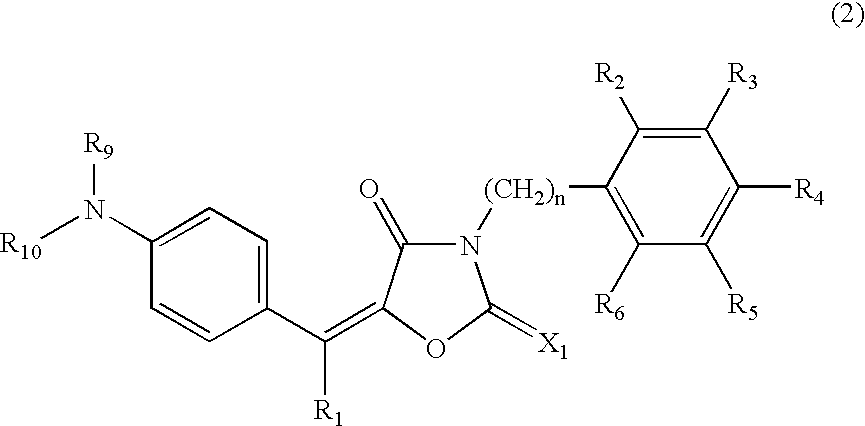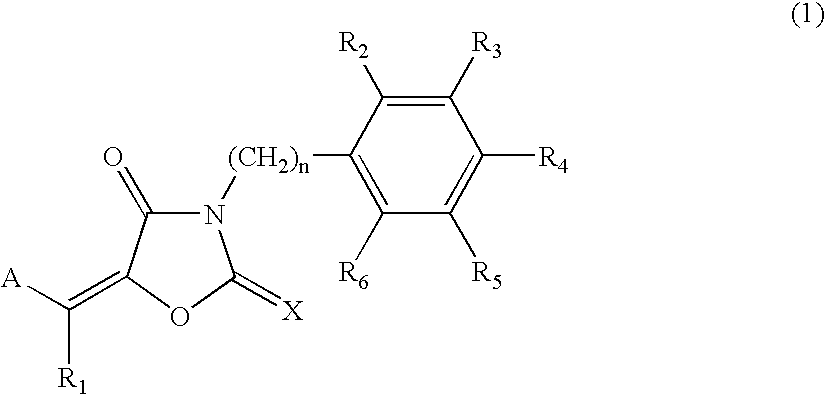Compound, photosensitive composition, lithographic printing plate precursor, and method of forming image
- Summary
- Abstract
- Description
- Claims
- Application Information
AI Technical Summary
Benefits of technology
Problems solved by technology
Method used
Image
Examples
synthesis example 1
Synthesis of (D1):
[0209]
[0210]Diphenylbenzaldehyde (4.1 g), 0.6 g of pyrrolidine and 3.5 g of 3-[2-(4-methoxyphenyl)ethyl]-1,3-oxazolidine-2,4-dione were dissolved in 50 ml of methanol and then stirred under reflux for 2 hours. After the completion of reaction, the solution was allowed to cool to room temperature, as a result, a yellow crystal was precipitated. The precipitated crystal was filtered, added to 100 ml of methanol and stirred for 1 hour. Thereafter, the crystal was filtered and dried to obtain 6.7 g of Compound (D1) (yield: 91%, purity: 99.3%).
[0211]The identification was performed by 1H-NMR (CDCl3), infrared absorption spectrum, mass spectrometry spectrum and elemental analysis. Melting point (149–152° C.), electron absorption spectrum (THF): absorption maximum wavelength: 397 nm, absorption maximum molar absorptivity: 37,100, oxidation potential (CH3CN, vs Ag / AgCl): +1.01 V.
example 22
[0271]A lithographic printing plate precursor was prepared in the same manner as in Examples 1 to 14 except that the initiation system was changed to have a composition shown below and the thickness of the photopolymerization layer was changed to 1.5 g / m2.
[0272]
Initiation systemD220.10 gA-10.15 gCo-sensitizerC-2 0.2 g
[0273]The obtained lithographic printing plate precursor was subjected to scanning exposure by using monochromatic light of 400 nm under the conditions of giving an exposure energy density of 0.25 mJ / cm2. Thereafter, the plate was heated at 100° C. for 10 seconds and then subjected to the above-described development treatment.
[0274]A lithographic printing plate having a blue image with excellent visibility was obtained. When offset printing was performed by using the obtained plate and using a press KOR-D manufactured by Heidelberg, 50,000 sheets or more of a printed matter having excellent image density and scumming resistance could be obtained.
example 23
[0275]The plate of Example 22 was exposed to yellow light for 1 hour before exposure and then plate-making and printing were performed thoroughly in the same manner as in Example 22. Good results completely the same as in Example 22 were obtained.
PUM
 Login to View More
Login to View More Abstract
Description
Claims
Application Information
 Login to View More
Login to View More - R&D
- Intellectual Property
- Life Sciences
- Materials
- Tech Scout
- Unparalleled Data Quality
- Higher Quality Content
- 60% Fewer Hallucinations
Browse by: Latest US Patents, China's latest patents, Technical Efficacy Thesaurus, Application Domain, Technology Topic, Popular Technical Reports.
© 2025 PatSnap. All rights reserved.Legal|Privacy policy|Modern Slavery Act Transparency Statement|Sitemap|About US| Contact US: help@patsnap.com



